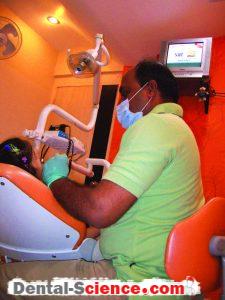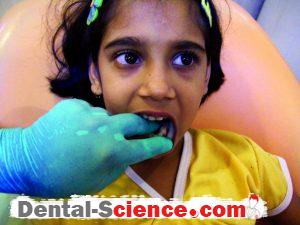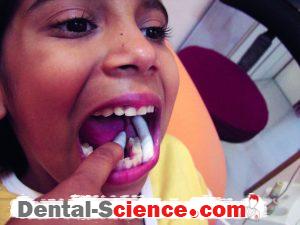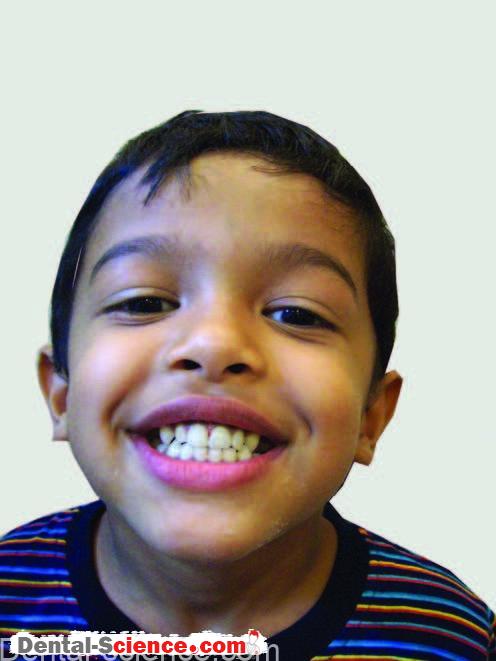Pain Management in Pediatric Dentistry
– The dental experience is often believed to be associated with pain.
– Many dental procedures are considered painful such as drilling teeth, injections, extractions of teeth, root canal treatments, etc.
– Parents, who have had past painful or traumatic dental experiences, often feel that the
children would have to go through the same.
– Even if a child does not have a past experience, he or she may be informed about ‘pain’ in
relation to dentistry both appropriately and inappropriately.
– The dental experience may not always be enjoyable, but certainly is not always painful.
– There are many unpleasant stimuli in relation to various dental situations which are actually much less intense and cannot be termed as ‘painful’.
Pain vs discomfort
– The dental experience may include a variety of discomforts such as the sensitivity
or vibrations of drilling, retraction of cheek, lips, placement of suction tip on mucosal
surface, feeling of tightness after cementation of a steel crown, placement of rubber dam clamp, etc.
– These experiences often make the child uncomfortable even in absence of real pain.
– Also, sometimes it is not easy to identify the cause of discomfort for a child in absence of pain.
– The dentist has to be good at managing both the ‘pain’ factor and the ‘discomfort’ factor.
Is dental treatment painful for children?
– The dental treatments are not entirely ‘pain-free’!
– The pain in dental procedures such as local anesthesia administration can be bearable for most patients, however, even with the best practices of pain management in dental clinics, possibility of pain-experience for a child cannot be ruled out.
– Whether the dental care is painful or not is determined by certain factors mentioned below:
1. Pain perception of children
2. Pain tolerance of children
3. Fears of children and pain
4. Use of anesthesia and analgesia in pain management
5. Successful behavior modification of the child
6. The dentist’s approach to the child’s pain
– Often, these factors are related to each other and are associated with each other.
1. Pain Perception of Children
– If a child imagines or is told to expect pain, even a minor discomfort would be perceived as pain by him/her.
– In absence of such a notion, however, even pain would often be well tolerated by a child many times.
– There are factors that affect pain perception of the child such as:
a. Past experience of pain
b. Information given to the child regarding dentistry and associated pain by peers and
family members
– The past experience of pain, particularly in a dental clinic or a medical setup may modify the child’s pain perception.
– The objective fear of pain reduces pain threshold of a child and thus the child is always
anticipating pain even while the dentist is carrying out absolutely non-traumatic work such as placing a cotton roll in mouth or only retracting the tongue or cheek with an instrument such as a mouth mirror.
– Parents, many a time, discuss their experiences of pain in front of children.
– Also, many parents threaten the children that they would be taken to the dentist/doctor if they misbehave.
– In certain societies, thus, doctors and dentists are the people feared most by the children!
– It is important for the dentist to know what the child is expecting in a dental situation and whether the child’s perception of pain is influenced by the above mentioned factors.
2. Pain Tolerance of Children
– Each child has a different tolerance capacity for pain. The dentist has to accept this fact.
– There is no ‘generalization’ possible regarding how much pain should be acceptable and
bearable to all children.
– The child’s genuine inability to tolerate a certain pain must be respected by the dentist and
a solution for the pain relief must be offered. Just because most children of a certain age accept certain procedures, the same must not be forced upon those who cannot receive them due to poor tolerance.
3. Fears of Children and Pain
– There are various associations of fear and pain. An important deterrent to seeking dental care is the child’s fear of dentistry.
– Children with fear of dentistry often have low pain threshold and thereby less tolerance.
– They also anticipate pain unnecessarily and react to non-painful stimuli as if they have
experienced pain!
– However, not all children with fear are intolerant to pain and not always does a painful
experience sets in fear.
– For example, there are extremely cooperative children who can go through most dental
procedures without any problems but are ‘needle phobic’.
– Hiding the needle, not mentioning words such as ‘injections’, distraction while administering local anesthesia and if required desensitization often take care of this problem.
– Also, some children do cry in pain when the local anesthesia is administered (on sites such as palatal mucosa, inferior alveolar nerve block), but can be comforted easily (if they have been behaviorally modified and are otherwise cooperative) and do not necessarily retain pain memory and develop fear of the same.
– It is always more difficult to manage fears than pain, hence, the behavior management skills of the dentist come first in the pain management and subsequent to that are the
anesthetics and analgesics!
4. Use of Anesthesia and Analgesia in Pain Management
– It is beyond the scope of this text to discuss the drugs used and their advantages and
disadvantages.
– It is imperative that the dentist uses appropriate anesthesia and analgesia in any dental
procedure and for even post-treatment relief.
– No dental treatment can commence if the anesthesia is not adequate and failure to
administer local anesthesia prior to a potentially painful treatment is detrimental to the quality of treatment as well as child cooperation.
5. Successful Behavior Modification of the Child
– Successful behavior modification is a prerequisite to pain management.
– Prior to taking necessary steps in pain management (such as administration of LA) the dentist must ask himself/herself questions such as:
– Is the child cooperative for dental treatment?
– Does the child give sufficient attention to the dentist and comply with all instructions?
– While in the dental chair, is he/she a ‘conditioned’ child?
– A dentist with effective child management skills, at times, can induce such relaxation in a child patient that the child is almost asleep or as good as asleep while the treatment is
being carried out!

6. The Dentist’s Approach to the Child’s Pain
– This factor needs elaborate discussion because the dentist has to work on developing an
approach towards understanding and management of the child’s pain in relation to
dentistry.
– Following are the guidelines for inculcating the right approach towards the child’s pain:
a. Never take any child for granted. All children are different and have different pain tolerance, pain perceptions, fears and anxieties.
b. Have a detailed talk with parents regarding the child’s past experiences of pain (particularly in a dental/medical situation), in the absence of the child.
c. Learn about the parent’s anxieties and how they have influenced the child’s behavior.
d. Win the confidence of the child. Assure the child that nobody wants him/her to experience any pain; however, do not assure that he/she will never experience any pain. Explain him/her that if he/she follows all instructions given by the dentist, the pain would be
minimal and bearable.
e. Inform the child that he/she can let you know if there is any pain, by raising a hand. If a child unnecessarily raises a hand tell him/her that you would not understand if there is real pain.
f. If the child experiences real pain and tells you that, accept it and offer sympathy. Do not
dismiss the child’s remarks. Tell him/her that only occasionally he/she might experience something like that, and you would do your best to prevent further pain and would want the child to help you for that by following all necessary instructions.
g. The administration of local anesthesia is an acquired skill. It has to be learnt and practiced well. There is no real alternative to it in the dental clinic.
h. Understand the limitations of pain control. For example, palatal injections are painful; local anesthetics do not attain good effect in presence of inflammation; some emergency
procedures may have to be carried out even without adequate pain control considering overall relief that it would bring about (abscess drainage in a severe acute dentoalveolar
abscess), etc.
i. Do not feel guilty if the child cries and experiences pain despite your best efforts of
administering local anesthesia and child management. Do not loose faith in the behavior modification methods due to a few failed attempts.
j. Prescribe the analgesic drugs in proper dosages and strengths.
k. Inform the child and the parent regarding possibility of post-treatment pain and how to take care of the same. An unexpected pain bothers a patient more than the expected pain.
l. The dentist must not only manage pain, but also reduce discomfort and fear. Syringe-loaded materials such as sealants, endodontic medicaments, etc. often simulate injections. A child often needs to be explained about them befor using them. The placement of cotton rolls, suction tips, mouth-props could result in mild discomfort, too! The dentist must take
utmost care in causing as less discomfort as possible; for example: the cotton roll should be of proper size and held in a correct manner, the suction tip should not touch loose mucosa, the mouth-prop should never rest on a painful, mobile tooth. Also, situations that can evoke fear such as heating a burnisher to seal gutta-percha points, should be carried out without the child noticing it.






Consequences of pain experience
– A painful experience may lead to either temporary loss of cooperation or even a permanent loss of cooperation if the child has not been behaviorally modified.
– The dentist has to anticipate what effect would be there in the child if he/she experiences pain.
– It may be required to be extra-cautious in not repeating a painful experience for a couple of visits after a relatively painful one so that the child does not view dentistry negatively.
– For example, if a child has undergone an extraction of a maxillary tooth for which palatal
infiltration was given, on the next couple of visits, only procedures with minimal/no pain such as post-endodontic restoration, must be taken up so as to allow the child to forget the traumatic experience.
– The ‘intentions’ of the dental team must be clear to the parents (and even to the children).
– It is important for them to know that we care for their pain. The dentist wants the child to have pain-free and healthy teeth; the treatment-related pain and discomfort are at times unavoidable factors in achieving this objective.
ــــــــــــــــــــ► ⒹⒺⓃⓉⒶⓁ–ⓈⒸⒾⒺⓝⓒⒺ ◄ــــــــــــــــــــ






